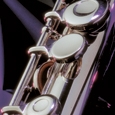A dozen years ago I quit my job as principal flutist of the Nashville Symphony Orchestra and began a career of teaching and writing – but not in the field of music. Instead I taught creative writing and wrote fiction and poetry. I wrote my first collection of short fiction, Listening to Mozart, while still playing in the orchestra. The stories followed the adventures of a flutist who had experiences very similar to mine.
How did I decide to become a flutist? I’ve always said I grew up in a non-musical family, but I have come to realize that is not true. My parents were not trained musicians, but we sang together from the time I was four. Then at age ten I carried a song flute everywhere with me and played it constantly. I must have been a terrible nuisance. In the fifth grade it was time to pick out an instrument and join the band. The band teacher had recommended the French horn. It would keep me busy, he said. My parents told me that the French horn would be too expensive, however, and suggested a trumpet or a clarinet. We were late on the evening when the kids chose their instruments. There were not many left, but there was a flute, a nickel-plated Bundy. I don’t know why, but I loved it at first sight. When we got home, I tried to get a sound out of it, but produced nothing but air and dizziness. My father could get it to sound (and he never let me forget it). A few lessons (well, maybe more) and several thousand hours of practice later, I could make a sound every time I picked up the flute.
One day I decided to take that Bundy apart. I had little screwdrivers, and I often took my fishing reels apart to clean and oil them. After I had taken it apart, I could not figure out how to put it back together again. I took it to the band director’s office in a paper bag. Soon after that, I got my second flute. After that first flute ended up in a grocery bag, there were other flutes that met kinder fates. I have played on dozens of flutes in my life and loved them all. I have had metal and wood flutes. (I eventually learned how to take them apart and to put them back together.) I have even played on bamboo flutes, most of which I made myself. I have many stories about those flutes.
My practicing got longer and my teachers became more beloved. I decided I wanted to be a professional flutist. I was not quite sure what that was because the only flutists I had ever heard were the musicians who played on the Lawrence Welk show, and they played all the woodwind instruments. I decided I would learn those other instruments just as soon as I had mastered the flute. (Of course, that never happened.) One night when we were driving to visit relatives in another town, we picked up a classical music station in St. Louis. The music I heard was wonderful, and it didn’t stop in three minutes. It kept on being wonderful – and I could hear a flute. Later I learned it was a Beethoven Symphony, and I decided I would like to play in an orchestra and learn Beethoven and Mozart. I listened to the Toscanini recordings of the Beethoven symphonies until I wore them out. A distant cousin of mine who played the flute told me about William Kincaid, the famous principal flutist of the Philadelphia Orchestra. He had made several records. I got the records and played along with them, something that wasn’t easy to do because the turntable turned too fast, and I could not get up to the pitch. I solved the problem by forcing the 45 rpm spindle down on top of the record to slow it down. Of course, it eventually wore a hole in the record.
Fast forward. After high school, I auditioned for William Kincaid at the Curtis Institute of Music in Philadelphia and was accepted. I was stunned. My family was stunned. My life changed. I was surrounded by people who loved music just as I did. I had always felt out of place, but now I was in heaven. Kincaid was wonderful. My classmates were wonderful. I got to live in an apartment and walk the streets of a big city. I had grown up in a little town in rural Missouri and could not believe the crowds surging up and down Chestnut Street at noon. At Curtis I played in the orchestra, in chamber ensembles, and for the two opera companies in the city.
Every opera was a new experience. The conductor got our attention by making kissing noises. Once he reached down and grabbed the piccolo player’s instrument and put it in his pocket during a performance because it was too loud. Another time the second flute player turned the page of my music during a solo. (He wanted to be the first flute.) I kept playing because I had memorized the music. .
First Lessons with Kincaid
Kincaid came to Curtis for the woodwind classes he conducted, but flute lessons were at his apartment, about two blocks down Locust Street. He was a handsome man with a courtly manner and a shock of white hair. The ladies in the common room treated him like royalty.
I walked past the piano, where that famous platinum flute was set up on a stand and unpacked my instrument. I had been playing the Dutilleux Sonatine, and I warmed up with some rapid scales. When I was done, Mr. Kincaid said something about me not needing to skate around anymore and we got down to business. I realized I had done something wrong, perhaps everything. We never got to the Dutilleux that day or any time that first year.
I learned a tone exercise and then was asked to play it in all keys, slowly, and with a full tone. (To see Kincaid’s exercise, click here.)
Then he brought out the Andre Maquarre Daily Exercises. These I was to learn from memory. Then there were scale and interval patterns which I copied into my notebook. Then Anderson Studies, beginning with Opus 33. (I had been playing Opus 60.) Instead of Dutilleux, I would play Kuhlau Divertissements. Better to work on expression than flashy fingers. I was to warm up with whistle tones, and sustain the C7, steady as a rock. He was very patient with me and showed, if anything, amusement rather than impatience.
I made several grumpy entries in my journal after the first lessons. I was not to skate around during my warmups. I was to play those whistle tones and hold them steady. It was hard to hold them steady. I was to listen to the more senior players and think about how they were producing their flute tones. I would work on musical expression rather than facility. When he played, I heard something startlingly noisy, a halo of white noise around the sound. This was the sound, I soon realized, that could cut through a giant orchestra. I wanted to be heard. I think this is important for a flutist, to really want to be heard.
My grumpy journal entries soon disappeared. After about four weeks I had become a good pupil. When I talked to my colleagues about their lessons, they described entirely different experiences. I realized that each of us had a different teacher, the one we needed. My first lesson was humility, and then came tone and expression. I am still grateful for them.





